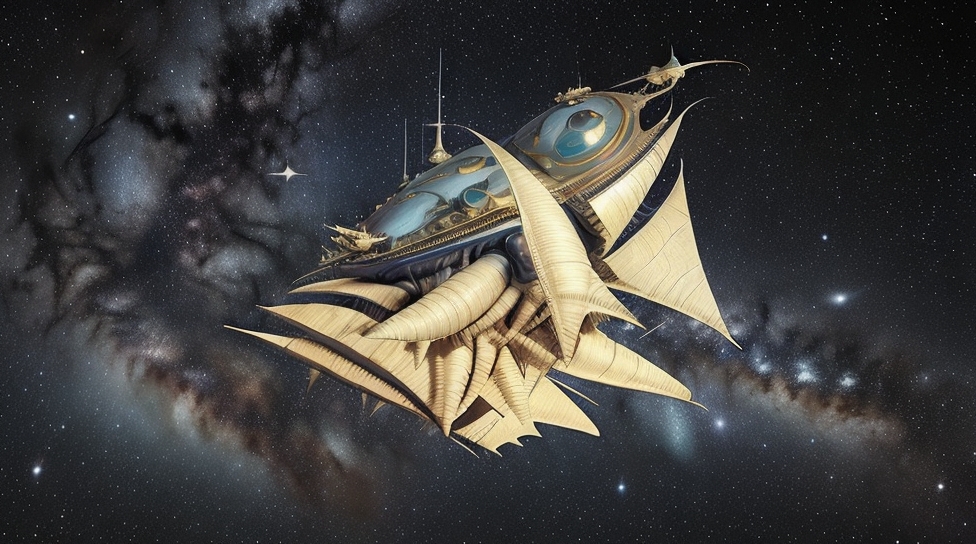Flow-pressure Space Ships
Flow-pressure ships (also "kiron-flow" ships) were developed after humans encountered the Klavangi in 2428-29. The first human flow-pressure ship prototype was piloted in 2439, using a combination of light-pressure design and irravir-based sail material. Several Diasporan worlds were working simultaneously to develop the technology, the first viable ship was prototypes in The Tellurian Federation but other worlds (notably Alamak and Jian Lu) were quick to develop workable models.
The addition of Danstan Generators made flow-pressure shipping the dominant supralight travel technology in the Diaspora by 2452.
See also: What are Kirons?
'
The addition of Danstan Generators made flow-pressure shipping the dominant supralight travel technology in the Diaspora by 2452.
See also: What are Kirons?
'
Power Generation
Most flow-pressure ships use a "combination" version of the Danstan Generators that acts as a power generator as well as creating and maintaining the hullfield. They run on tachyon bricks but supplemental power can be provided by plasma packs.
The ship's Danstan field is also what makes sail-rigging possible, creating a generated force field that encloses a ship with its inner course of sails and standing rigging and provides some protection from micro-asteroids and space debris along with a weak gravitational pull to the ship hull. For purposes of working on the rigging it can also be "charged" to hold a breathable oxygen atmosphere.
For non-propulsion power functions (and as backup to the Danstan Generator) flow-pressure ships are equipped with power panels mounted on the hull to collect light and other wave-power sources, which can be stored in power batteries.
The ship's Danstan field is also what makes sail-rigging possible, creating a generated force field that encloses a ship with its inner course of sails and standing rigging and provides some protection from micro-asteroids and space debris along with a weak gravitational pull to the ship hull. For purposes of working on the rigging it can also be "charged" to hold a breathable oxygen atmosphere.
For non-propulsion power functions (and as backup to the Danstan Generator) flow-pressure ships are equipped with power panels mounted on the hull to collect light and other wave-power sources, which can be stored in power batteries.
Propulsion
Sails
To use kiron propulsion ships need three "suits" of sails:- The "spinnaker suit" for supralight propulsion
- The "foreaft suit" for transitions from sublight to supralight and vice-versa
- The "square suit" for insystem maneuvering
The first two are true irravir flow-propulsion sails, square suit sails are hybrid flow-propulsion and light-pressure. Sails are mounted on booms that brace to deployment masts.
Most kiron-propulsion ships also have one or more power drive systems for insystem use. A few dual kiron/tachyon drive ships do exist mostly for long-distance bulk cargo purposes, but the less massy, slower and cheaper web-drive engines are more commonly mounted for insystem purposes.
Sail technology is limited to some extent by the mass ratio of the ship to sail acreage and practical limits make supralight kiron propulsion uneconomic for bulk haulage. The weight issue is addressed to some extent with the Danstan Generators hullfield technology and use of ultralight materials for internal structures and rigging. Mass issues also limit the types and numbers of weapons that can be mounted on kiron-flow ships.
Unlike water-sailing ships, space sails and rigging deploy along the maneuver keel ("underside" or running along the maneuver hull) and sides of the ovoid ships although the spinnaker and foreaft topgallants curve up to almost meet "above" the ship's axis of direction (they are called "archangels" from their resemblance to giant wings.) The fastest ships may also deploy a "storm blade" outrigger from the stern and braking foils from the prow or forecastle top.
Weapons & Armament
Weapons on space sailing ships are mounted at the stern and along the topline of the conning hull on both sides; while there are as yet no weapons systems that function at supralight speeds, several varieties of powered and ballistic missile systems are used in sublight conditions as well as EMD Beam and passive ordnance systems such as mines and sailtrap nets.
Armor and defense
Since close quarters combat often involves hostile boarding attempts, most space sailing ships have passive defense systems such as boarding curtains, boat traps, etc. and standing rigging for ships-of-war includes combat manning stations or platforms.
Communication Tools & Systems
No communications are possible during FTL travel, but flow-pressure ships are ComWeb-equipped for in- and near-system communications at low multiples of lightspeed for short distances, and have BeaconLink transceivers to access the Beacon Net system when in range.
Additional & auxiliary systems
Maneuvering
Once sails are fully mounted, a gyroscope or momentum wheel changes the angle of the masts to adjust sail surface. Sails control motion along the x axis (forward, back) and contribute to other motions. Stern rudders control y-axis direction or "heading", and forward beam kilerons along the constrakes provide direction along the z-axis, "pitch".The upper hull surface (above the constrake) is called the "conning hull" and the lower hull surface from which the the deployment masts are rigged is called the "maneuver hull".
Deck Architecture
The largest flow-pressure ships are designed with deck extensions of the conning hull, such as a quarterdeck and/or forecastle. Most flow-pressure ships have a deck configuration from the conning hull ("top") to the maneuver hull ("bottom") that includes the following:- arms tier - in armed ships
- coll deck - or in armed ships, the "upper gundeck"
- lower gundeck - larger ships only
- Danstan tier - always the centralmost deck space, with variable-g
- Engineering deck
- Power deck - larger ships only
- orlop deck
- Deploy tier



Comments